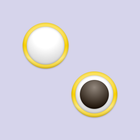Plasmonic nanoparticles - including gold, silver and platinum particles - are discrete metallic particles that have unique optical properties due to their size and shape, and are increasingly being incorporated into commercial products and technologies. These technologies, which span fields ranging from photovoltaics to biological and chemical sensors, take advantage of the extraordinary efficiency of plasmonic nanoparticles at absorbing and scattering light. Additionally, unlike most dyes and pigments, plasmonic nanoparticles have a color that depends on their size and shape and can be tuned to optimize performance for individual applications without changing the chemical composition of the material: for example, the solutions below contain gold or silver nanoparticles with controlled size and shape that tunes their optical response, resulting in vibrantly colored dispersions.

This module describes the origin of the surface plasmon resonance in metal nanoparticles and introduces the resulting optical properties for this interesting class of materials.
Plasmonic Nanoparticles
Plasmonic nanoparticles are extremely strong absorbers and scatters of light and are used in lateral flow diagnostics, surface enhanced spectroscopy, labeling, and color changing sensors. By changing nanoparticle size, shape, and composition, the optical response can be tuned from the ultraviolet through the visible to the near-infrared regions of the electromagnetic spectrum. By shifting the absorption and scattering, the color of nanoparticle dispersions and films can also be tuned: for example, solutions of spherical gold nanoparticles are ruby red in color due to the strong scattering and absorption in the green region of the spectrum, while solutions of silver nanoparticles are yellow due to the plasmon resonance in the blue region of the spectrum (red and green light is unaffected).

In addition to metal nanoparticles, there have been recent examples of metal oxide nanoparticles doped with other metal atoms that show strong and tunable plasmon resonances. By changing the particle size, dopant and dopant concentration, plasmon resonances in the near-infrared (NIR) and short-wavelength infrared (SWIR) have been fabricated.
What is a Surface Plasmon Resonance?
The remarkable optical properties of plasmonic materials occurs because the conduction electrons on the nanoparticle surface undergo a collective oscillation when excited by light at specific wavelengths (shown below). This oscillation, which is known as a surface plasmon resonance (SPR), results in the unusually strong scattering and absorption of light. When these resonances are excited, absorption and scattering intensities can be up to 40x higher than identically sized particles that are not plasmonic.

The Physics of Plasmon Resonances
The basis for the effect is the plasmon resonance of the free electrons in the metal nanoparticle, which can be understood by studying the polarizability (the ease with which charges, such as the conduction electrons on the metal nanoparticle surface, undergo charge distribution and form partial dipoles). For a spherical nanoparticle, the quasi-static polarizability of the nanoparticle is given by
 where ε1 is the wavelength dependent dielectric function of the nanoparticle and ε2 is the dielectric function of the medium which remains roughly constant regardless of wavelength. When the condition Re{ε1} = -2ε2 is satisfied, the particle is driven into resonance resulting in a strong increase in the absorption and/or scattering at that wavelength. The resonance condition depends on the wavelength dependent dielectric function of the nanoparticle as well as the dielectric function of the medium. Consequently, the nanoparticle optical properties are highly dependent on material composition, size, and the medium in which the particles are embedded. For example, increasing the aspect ratio of gold nanorods causes the plasmon resonance to shift from the visible into the NIR, as shown below.
where ε1 is the wavelength dependent dielectric function of the nanoparticle and ε2 is the dielectric function of the medium which remains roughly constant regardless of wavelength. When the condition Re{ε1} = -2ε2 is satisfied, the particle is driven into resonance resulting in a strong increase in the absorption and/or scattering at that wavelength. The resonance condition depends on the wavelength dependent dielectric function of the nanoparticle as well as the dielectric function of the medium. Consequently, the nanoparticle optical properties are highly dependent on material composition, size, and the medium in which the particles are embedded. For example, increasing the aspect ratio of gold nanorods causes the plasmon resonance to shift from the visible into the NIR, as shown below.

Nanoparticle optical properties are also sensitive to the proximity of other plasmonic materials. When two or more plasmonic nanoparticles are near each other (with edge-to-edge separations of one particle diameter or less) their surface plasmons couple as the conduction electrons on each particle surface collectively oscillate. This effect is similar to molecular orbital theory in that plasmon coupling results in the oscillating electrons assuming the lowest energy state, causing the plasmon resonance wavelength of the coupled particles to red-shift to longer wavelengths (lower energies). This coupling effect is responsible for the dramatic changes in the visible color of plasmonic nanoparticle solution when nanoparticles aggregate and also the basis of many different types of plasmonic nanoparticle sensors.
Modeling the Optical Response of Plasmonic Nanoparticles
At nanoComposix, we use modeling to predict the optical properties of a nanoparticle of a given size and shape in order to target morphologies to fabricate particles that will resonate at a desired wavelengths (e.g. with a specific laser line), as well as for quality control purposes to ensure that our nanoparticles are highly monodisperse and have uniform shapes.
Modeling for spherical nanoparticles is typically performed using Mie theory. Mie theory is not actually a theory, but rather is the analytical solution of Maxwell’s equations for the scattering of light by a spherical particle. Mie theory can be used to calculate the scattering from spheres of any diameter at any wavelength of light. While classical Mie theory assumed that the sphere would be composed of a single material, more recently, Mie theory has been adapted to solve light scattering from layered spheres. At nanoComposix, we have written a custom Mie theory code to calculate the extinction, absorption, and scattering from metal and dielectric nano- and micro-particles. Our online Mie Theory calculator allows you to choose nanoparticle size, composition, and the properties of the media surrounding the particles, and calculate the scattering and absorption spectrum.
Additional Resources
Recommended Literature
- Eustis, S., & El-Sayed, M. A. "Why gold nanoparticles are more precious than pretty gold: noble metal surface plasmon resonance and its enhancement of the radiative and nonradiative properties of nanocrystals of different shapes." Chemical Society Reviews, 35(3), 209-217 (2006).
- Willets, K. A., & Van Duyne, R. P. "Localized surface plasmon resonance spectroscopy and sensing." Annual Review of Physical Chemistry, 58, 267-297 (2007).
- Barnes, W. L., Dereux, A., & Ebbesen, T. W. "Surface plasmon subwavelength optics." Nature, 424(6950), 824-830 (2003).
For more information on selecting particles for your research or applications please contact us.



